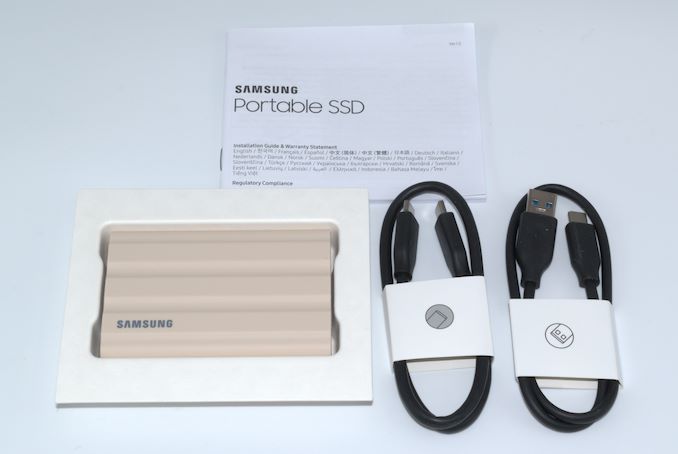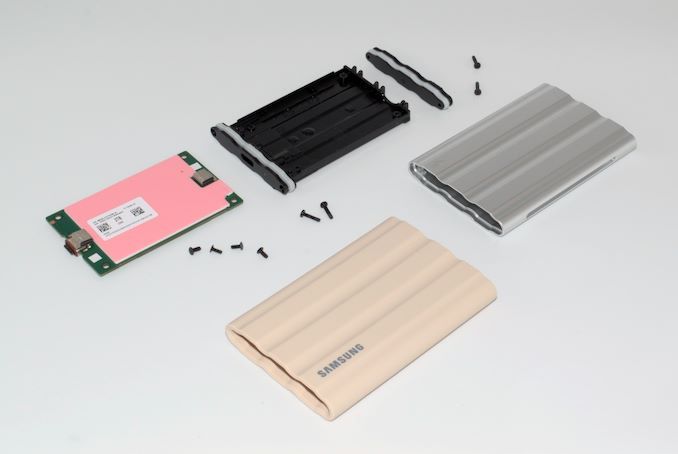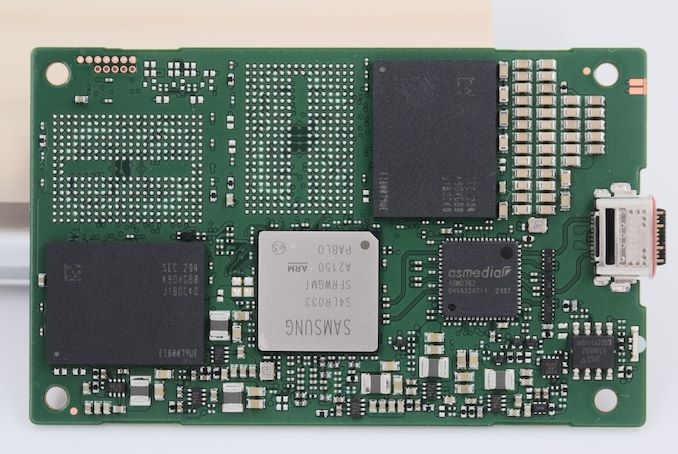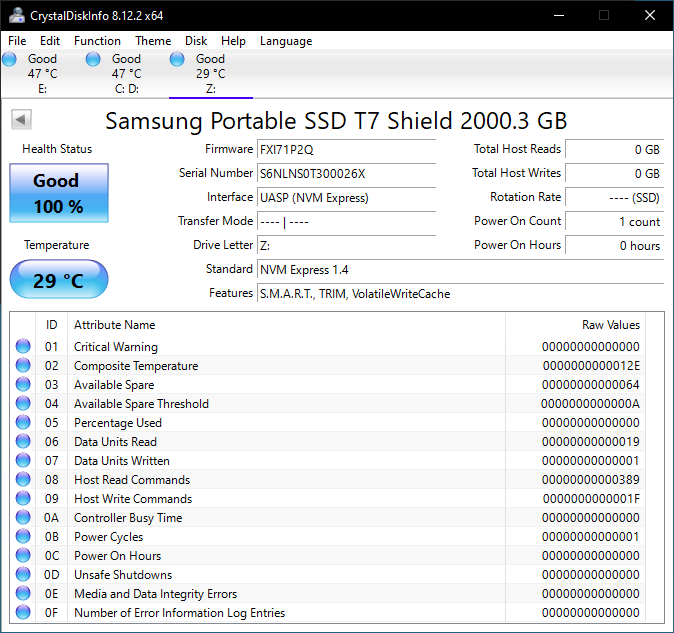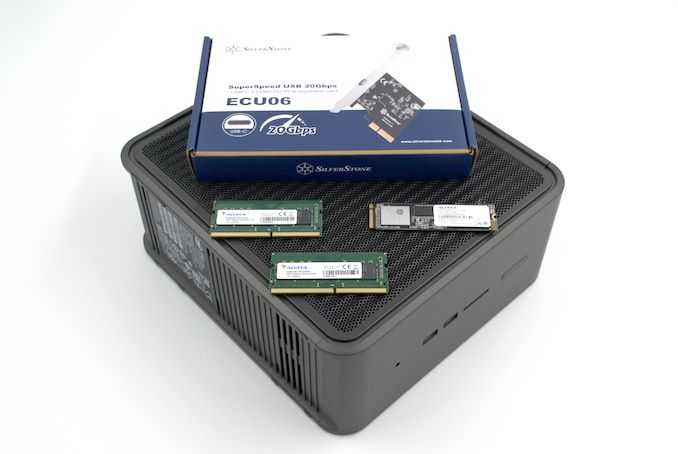Samsung’s lineup of portable SSDs has enjoyed tremendous success, starting with the T1 back in 2015. The company has been regularly updating their PSSD lineup with the evolution of different high-speed interfaces as well as NAND flash technology.
Earlier this year, Samsung launched the Portable SSD T7 Shield, a follow-up to the Portable SSD T7 (Touch) introduced in early 2020. Samsung is mainly advertising the ruggedness / IP65 rating of the T7 Shield as a selling point over the regular Portable SSD T7 and T7 Touch. Today’s review takes a look at the performance and value proposition of the Portable SSD T7 Shield. Our detailed analysis in the review below reveals another trick that Samsung has up their sleeve, which makes the T7 Shield a worthy successor (rather than just an addition) to the Portable SSD T7 family.
Introduction and Product Impressions
External bus-powered storage devices capable of 1GBps+ performance have become entry-level offerings in the market today. Rapid advancements in flash technology (including the advent of 3D NAND and NVMe) as well as faster host interfaces (such as Thunderbolt 3 and USB 3.2 Gen 2+) have been key enablers. Broadly speaking, there are five distinct performance levels in this market:
- 2GBps+ drives with Thunderbolt 3 or USB4, using NVMe SSDs
- 2GBps drives with USB 3.2 Gen 2×2, using NVMe SSDs or direct USB flash drive (UFD) controllers
- 1GBps drives with USB 3.2 Gen 2, using NVMe SSDs or direct UFD controllers
- 500MBps drives with USB 3.2 Gen 1 (or, Gen 2, in some cases), using SATA SSDs
- Sub-400MBps drives with USB 3.2 Gen 1, using UFD controllers
The Samsung Portable SSD T7 Shield we are looking at today belongs to the third category in the above list, utilizing a NVMe SSD behind an ASMedia ASM2362 bridge chip. The configuration is quite similar to the Portable SSD T7 (Touch) in terms of the NVMe controller and the bridge chip. There are a few industrial design updates to protect the drive against dust ingress and splashes of water (IP65), as well as lend it an element of ruggedness. The striking externally visible one is the addition of an elastomer covering (available in beige, blue, and black) to the internal metal case. The new casing also has a few ridges that run across the longer side.
Samsung includes two separate cables – one USB Type-C to Type-A, and another Type-C to Type-C of approximately the same length. Disassembling the unit is fairly trivial after taking out the four screws hidden under the product label stickers on either side, and removing the elastomer covering. This reveals an aluminum metal enclosure. The plastic tray holding the actual PSSD board can then be slid out after the removal of the plastic piece opposite the connector end. Both plastic end pieces have grommets around their periphery to ensure a good seal and contribute to the IP65 rating. The main board is held on to the plastic tray by four smaller screws. The connector on the main board has a red-colored sealing band to ensure that it doesn’t become an ingress point for external material.
A full teardown gallery is also presented above. It shows that one side of the board is covered with a thermal pad despite having no components on its side. The removal of the thermal pad on the other side reveals the controller and the flash packages. The SSD controller is the S4LR033, and the ASMedia ASM2362 bridge chip is right next to it. The SSD subsysem in the PSSD T7 Shield is a DRAM-less one, and is pretty much the same as that of the T7 Touch – except for the flash packages. The two flash chips on board have the K9DVGB8J1B tag (against the K9DVGY8J5A in our sample of the PSSD T7 Touch). This part number decodes as: TLC, 6th gen V-NAND (128L / 136T), 512Gbit per die, 16 dies, 1TB for the whole package. This is the same NAND package used in Samsung 870 EVO SATA SSD.
Moving from the 5th Gen. 92L (96T) V-NAND in the T7 Touch to the 6th Gen. 128L (136T) V-NAND brings about a 10% improvement in latency and 15% reduction in power consumption, as per Samsung’s claims. As we shall discovered further down in this review, these aspects do bear out when looking at various evaluation results.
The review compares the Samsung Portable SSD T7 Shield 2TB against the other 2TB drives reviewed earlier using our latest direct-attached storage test suite. We have also added the Samsung Portable SSD T7 Touch 1TB to the mix, even though it doesn’t make for an apples-to-apples comparison. The list of PSSDs considered in this review is provided below.
- Samsung T7 Shield 2TB
- SanDisk Professional G-DRIVE 2TB
- SanDisk Professional G-DRIVE ArmorLock 2TB
- Kingston XS2000 2TB
- Samsung T7 Touch 1TB
A quick overview of the internal capabilities of the storage devices is given by CrystalDiskInfo. The Samsung PSSD T7 Shield supports full S.M.A.R.T passthrough, along with TRIM to ensure consistent performance for the drive over its lifetime.
The table below presents a comparative view of the specifications of the different portable SSDs presented in this review.
| Comparative Direct-Attached Storage Devices Configuration | ||
| Aspect | Samsung T7 Shield 2TBSDP G-DRIVE 2TBSDP G-DRIVE ArmorLock 2TBKingston XS2000 2TBSamsung T7 Touch 1TB | SDP G-DRIVE 2TBSDP G-DRIVE ArmorLock 2TBKingston XS2000 2TBSamsung T7 Touch 1TBSamsung T7 Shield 2TB |
| Downstream Port | PCIe 3.0 x2 | 1x PCIe 3.0 x4 (M.2 NVMe) |
| Upstream Port | USB 3.2 Gen 2 Type-C | USB 3.2 Gen 2 Type-C (Male) |
| Bridge Chip | ASMedia ASM2362 | ASMedia ASM2362? |
| Power | Bus Powered | Bus Powered |
| Use Case | Light-weight 1GBps-class portable SSD with a durability focus (IP65 rating) | 1GBps-class, IP67-rated rugged portable SSD for on-the-go content capture workflows |
| Physical Dimensions | 88 mm x 59 mm x 13 mm | 95 mm x 50 mm x 15 mm |
| Weight | 98 grams | 91 grams |
| Cable | 45 cm USB 3.2 Gen 2 Type-C to Type-C 45 cm USB 3.2 Gen 2 Type-C to Type-A |
49 cm USB 3.2 Gen 2 Type-C to Type-C 48 cm USB 3.2 Gen 2 Type-C to Type-A |
| S.M.A.R.T Passthrough | Yes | Yes |
| UASP Support | Yes | Yes |
| TRIM Passthrough | Yes | Yes |
| Hardware Encryption | Yes | Yes (256-bit AES, only via SanDisk Secure App) |
| Evaluated Storage | Samsung 128L (136T) V-NAND (6th Gen.) | SanDisk BiCS 4 96L 3D TLC |
| Price | USD 234 | USD 360 |
| Review Link | Samsung Portable SSD T7 Shield 2TB Review | SanDisk Professional G-DRIVE SSD 2TB Review |
Prior to looking at the benchmark numbers, power consumption, and thermal solution effectiveness, a description of the testbed setup and evaluation methodology is provided.
Testbed Setup and Evaluation Methodology
Direct-attached storage devices (including portable SSDs) are evaluated using the Quartz Canyon NUC (essentially, the Xeon / ECC version of the Ghost Canyon NUC) configured with 2x 16GB DDR4-2667 ECC SODIMMs and a PCIe 3.0 x4 NVMe SSD – the IM2P33E8 1TB from ADATA.
The most attractive aspect of the Quartz Canyon NUC is the presence of two PCIe slots (electrically, x16 and x4) for add-in cards. In the absence of a discrete GPU – for which there is no need in a DAS testbed – both slots are available. In fact, we also added a spare SanDisk Extreme PRO M.2 NVMe SSD to the CPU direct-attached M.2 22110 slot in the baseboard in order to avoid DMI bottlenecks when evaluating Thunderbolt 3 devices. This still allows for two add-in cards operating at x8 (x16 electrical) and x4 (x4 electrical). Since the Quartz Canyon NUC doesn’t have a native USB 3.2 Gen 2×2 port, Silverstone’s SST-ECU06 add-in card was installed in the x4 slot. All non-Thunderbolt devices are tested using the Type-C port enabled by the SST-ECU06.
The specifications of the testbed are summarized in the table below:
| The 2021 AnandTech DAS Testbed Configuration | |
| System | Intel Quartz Canyon NUC9vXQNX |
| CPU | Intel Xeon E-2286M |
| Memory | ADATA Industrial AD4B3200716G22 32 GB (2x 16GB) DDR4-3200 ECC @ 22-22-22-52 |
| OS Drive | ADATA Industrial IM2P33E8 NVMe 1TB |
| Secondary Drive | SanDisk Extreme PRO M.2 NVMe 3D SSD 1TB |
| Add-on Card | SilverStone Tek SST-ECU06 USB 3.2 Gen 2×2 Type-C Host |
| OS | Windows 10 Enterprise x64 (21H1) |
| Thanks to ADATA, Intel, and SilverStone Tek for the build components |
The testbed hardware is only one segment of the evaluation. Over the last few years, the typical direct-attached storage workloads for memory cards have also evolved. High bit-rate 4K videos at 60fps have become quite common, and 8K videos are starting to make an appearance. Game install sizes have also grown steadily even in portable game consoles, thanks to high resolution textures and artwork. Keeping these in mind, our evaluation scheme for direct-attached storage devices involves multiple workloads which are described in detail in the corresponding sections.
- Synthetic workloads using CrystalDiskMark and ATTO
- Real-world access traces using PCMark 10’s storage benchmark
- Custom robocopy workloads reflective of typical DAS usage
- Sequential write stress test
In the next section, we have an overview of the performance of the Samsung Portable SSD T7 Shield in these benchmarks. Prior to providing concluding remarks, we have some observations on the PSSD’s power consumption numbers and thermal solution also.

